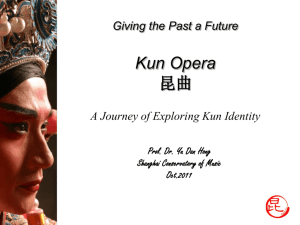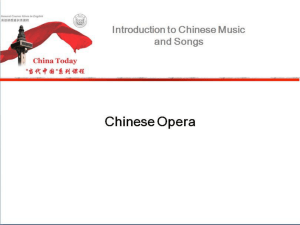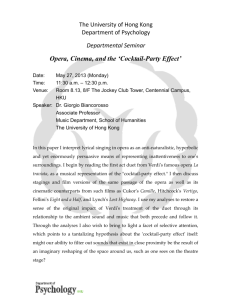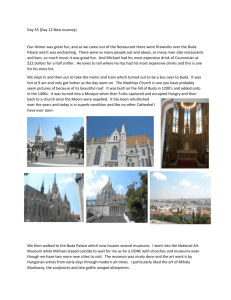An Introduction to Kunqu - Portland State University
advertisement
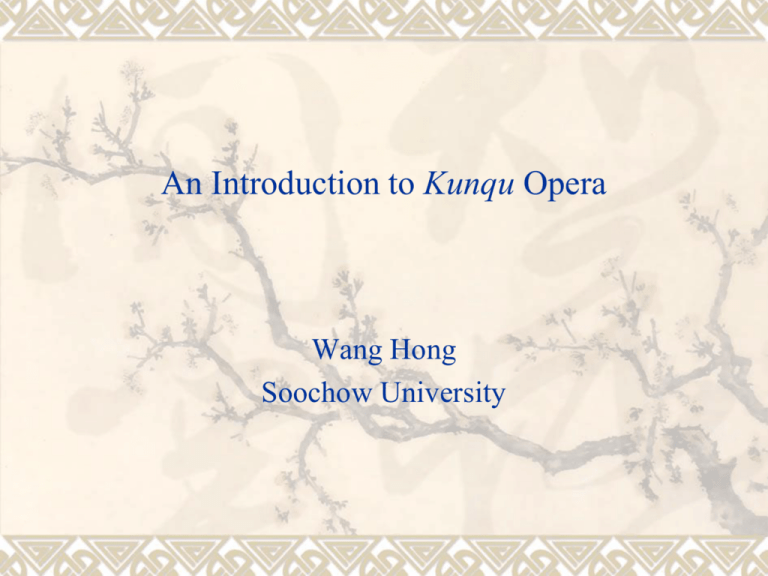
An Introduction to Kunqu Opera Wang Hong Soochow University Major points: 1. Lead-in: 2.The History of Kunqu Opera 3.The Performing System 4.The Representative Masterpieces 5.The Translation of Flirting with the Zither from The Jade Hairpin《玉簪记·琴挑》 1. Lead-in: about Kunqu Opera 600-year-old, known as the Mother of Chinese Opera. An art form that uniquely blends poetic eloquence, musical refinement and dramatics and leaves profound influence on other forms of Chinese opera. The first and foremost Chinese performing art proclaimed by UNESCO as one of the Masterpieces of the Oral and Intangible Heritage of Humanity. What is Special About Kunqu? Musical Instruments 乐器 Bamboo flute as the principal musical instrument Other wind and string instruments may be added to enhance the beauty Stage Setting 舞台 Unrealistic, thus appeals to the audience's imagination Movements 身段 Performed with set conventions An ingenious combination of reality with the reality of arts Tonal Patterns 曲牌 Fixed. Kunqu poetry is written to fit a large number of fixed tonal patterns embedded with Chinese language. The Peony Pavilion: the Most Famous Kunqu Opera It was written b y T a n g Xianzu, the greatest poet playwright of the Ming Dynasty (1368-1644), also regarded as the “Chinese Shakespeare ”. This play was oftentimes referred to as the Chinese Romeo and Juliet. A Synopsis of An Amazing Dream 第十出 惊 梦 [旦]不到园林,怎知春色如许! 【皂罗袍】 原来姹紫嫣红开遍, 似这般都付与断井颓垣。 良辰美景奈何天, 赏心乐事谁家院! Scene Ten An Amazing Dream DU LINIANG: If I had not come to the garden, how could I have tasted the beauty of spring! (To the tune of Zaoluopao) The flowers glitter brightly in the air, Around the wells and walls deserted here and there. Where is the “pleasant day and pretty sight”? Who can enjoy “contentment and delight”? 2.The History of Kunqu Opera Kunqu Opera was born from the art form of chuanqi 传奇 (romance play) in ancient China. In history, the term chuanqi underwent several changes in its connotations. For instance, the classical Chinese short stories in the Tang Dynasty were also called chuanqi. But in drama, this term was specified to mean a long play with standardized literary patterns and regular musical schemes. The scripts of chuanqi were often stories with intricate and fantastic plots and detailed descriptions of emotions and romances to achieve thrilling and dramatic effects. The scripts of chuanqi were sung in diverse local tunes of different regions. At the end of the Yuan Dynasty and the beginning of the Ming Dynasty, the following four tunes were prevalent in the south (the areas south of the Yangtze River). They were the Yuyao tune(余姚腔), Haiyan tune(海盐腔), Yiyang tune(弋阳腔) and Kunshan tune(昆山腔)—all were after the names of the four areas. The Kunshan tune was applied to singing chuanqi scripts and the singers simply played their roles without wearing make-ups. The Haiyan tune was sung in the official language, and its elegance catered well for the scholar-officials and the literati while the Yiyang tune was welcomed by the common people for its sonorous liveliness accompanied by gongs and drums. In the developmental process of Kunqu Opera, the reform of the Kunshan tune was a key step. Carried out by Wei Liangfu(魏良 辅) , this reform covered three aspects. The first was the improvement of its singing techniques. It required that the modulation should abide by the rules of the level, rising, falling and entering tones—the four tones of the classical Chinese pronunciation and intonation. The second was about the innovation of the original tune, and treating the chanting with more elaboration to make it sound softer and finer. That was the reason the refined tune was referred to as the milling tune (as if being polished finely with a water mill) by people at that time. The third was concerned with incorporating more vigorous elements into the Kunshan tune. A southern tune in origin, the Kunshan tune used to be more gentle than strong. As a result, it could not fully express ardent emotions. In the course of the reform, this defect was compensated for by the dramatists’ efforts in drawing on many elements from northern dramas to make the Kunshan tune more forceful and expressive. From the perspective of musical accompaniment, Wei Liangfu and other artists modified the traditional orchestra by picking the essence out of the various zithers, wood and bamboo pipes, drums and clappers from both the northern and southern dramas. A new form of the accompanying band was introduced, with string, wind, and percussion instruments. The reformed Kunshan tune captured people’s attention with its clear, soft, pleasant and harmonious effect, and soon became very popular. Thereafter, the Kunshan tune became all the rage and soon developed from a single tune into a nation-wide major opera form. People then began to call the tune Kunqu or Kunqu opera. Kunqu Opera ranks among the most splendid and miraculous cultural art forms created by the Chinese people in their long history. After it came into being at the district of Kunshan near Suzhou during the late Yuan Dynasty in the mid-14th century, Kunqu Opera was artistically refined over a period of 200 years and stood out prominently among the various competing schools of operas in China for its “delicate tunes and elegant melodies”. With Suzhou as its base, Kunqu Opera soon became fashionable both at home and abroad, forming, for hundreds of years, the spectacular scene of “all operas taking Kunqu as their ancestor”. After China entered the modern age, Kunqu Opera underwent a gradual decline from its zenith, due to the rapid dramatic changes in the Chinese society. As time went by, Kunqu Opera lost favor with many of its audiences and its popularity and social influence diminished year after year. Fortunately, it survived and remained to be the most influential traditional opera owing to the profound foundation it accumulates in the area of script writing, performing art and theoretical research. Not a single school of opera in China could parallel it in status, let alone surpass it. There is no denying that Kunqu Opera embodies the highest artistic achievements that the traditional Chinese drama has ever accomplished and maintains a unique position in the history of the world culture. A good case in point is that Kunqu Opera was honored by UNESCO as one of 19 outstanding cultural forms of expression from different regions of the world "Masterpieces of the Oral and Intangible Heritage of Humanity” in May 2001. 3. The Performing System of Kunqu Opera The performance of Kunqu opera gave the utmost importance to singing. With the reforms of Wei Liangfu and others, the techniques used in singing the Kunshan tune were greatly enhanced. In addition, many important theoretical works on drama composition and phonation appeared. Great books such as Nine Music Notes and Thirteen Tunes of Nanxi 《南九宮十三调 曲谱 》and Guide for Singing in Drama《唱曲当知》 written by Shen Jing 沈璟, Theories on Dramas 曲律》 by Wang Jide 王骥德, Guides for Composing Music in Dramas 《度曲须知》 by Shen Chongsui 沈宠绥, Yuefu Music《乐府传声》by Xu Dachun 徐大椿, Yin Lu’s Talks on Drama Music 《螾庐曲谈》 by Wang Jilie 王 季 烈 were published. Gradually, a whole framework of the theoretical system for Kunqu opera was developed. In terms of role types in Kunqu Opera, the original “five major role types of sheng 生, dan 旦, jing 淨, mo 末, chou 丑” underwent further specification. During the reigns of Emperor Qianlong and Emperor Jiajing in the Qing Dynasty, the vogue for scholars’ families to perform opera scenes contributed greatly to the specialization and particularity of the roles. According to The History of Drama in Suzhou 《苏州戏曲志》, the role types in modern Kunqu opera are divided into the following types: 1) Sheng 生 (young male character): Guansheng 冠生/官生(young male character wearing a hat) Jinsheng 巾生(young male actor with a head-covering and a fan in hand such as Liu Mengmei in the Peony Pavilion) Zhiweisheng雉尾生 (young male character with feathers on a hat such as a sour scholar) Wusheng 武生 (young male character good at fighting) 2)Dan 旦 (female character): Laodan 一旦/老旦(old female character) Zhengdan 二旦/正旦(married, middle-aged female character) Zuodan 三旦/作旦(little girl character) Sidan 四旦 /刺杀旦 (shrewish female character) Wudan 五旦/闺门旦(elegant young lady character such as Du Liniang in the Peony Pavilion) Liudan 六旦/贴旦(lively young lady character such as Chunxiang in the Peony Pavilion) 3)Jing 淨 (male character with face makeup): Hongjing 紅淨(character with red face makeup) Heijing 黑淨(character with black face makeup) Baijing 白淨 (character with white face makeup) 4)Mo 末 (middle-aged or old male character): Laosheng 老生(middle-aged male character with high social status, the leading role) Laowai 老外 (elder character with experience of life, such as high court officials) Fumo 副末(middle-aged male character with low social status, the supporting role) 5)Chou 丑 (comedy character): Fuchou 付丑 (character of high social status with treacherous personality) Xiaochou 小丑 (character who was kind and funny, but of low social status) The specialization of characters led to the standardization of the performance. The standardization in turn required better portrayal of the characters’ dispositions described in the drama scripts to make the performance more exciting. In the book called Notes of Random Thoughts 《闲情偶記》 written by the dramatist Li Yu 李渔 at the beginning of the Qing Dynasty, the section “Performing Practices” elaborated on what he had learned from the practice of performing. The book Origin of Drama 《梨园原》 (also named Mirror of the Heart《明心鉴 》), spread by hand-copy during the reign of Emperor Qianlong 乾隆, also summarized what the actors thought about their acting. The thorough research gave a theoretical summary of Kunqu Opera performance from various aspects, covering singing, reciting, acting, dancing, hand gestures, eye movements, body postures, techniques of maneuvering the body and gait. There is actually another kind of roles of little importance in the opera and therefore they are not taken as the main type of characters in the opera. They are extras with no names or titles, such as carters, boatmen, umbrella men, unimportant minor officials, eunuchs, maids in the imperial palace, and utility men. Generally speaking, a traditional Kunqu Opera troupe only needs 18 actors and actresses in total. Only in a few very big opera troupes there are 27 performers. Normally a troupe that has ten performers can give performances and other characters in need can be replaced by those whose roles are the similar types. The ten performers mentioned above are also called 'Ten Main Pillars' of the troupe, and they are Jing, Guansheng, Jinsheng, Laosheng, Mo, Zhengdan, Wudan, Liudan, Fuchou, and Xiaochou, and the quality of the performance mainly depend on the acting of four roles, including Jing, Guansheng, Zhengdan and Wudan. Different types of the roles in Kunqu Opera have their own special performing movements, languages, skills and procedures, which play a very important part in portraying the personalities and mental states of the characters as well as dramatizing the plot and elevating the appeal of the opera. As a result, the intact and unique performing system of Kunqu Opera has been formed. Kunqu Opera also has a complete system of acting as well as its own distinctive tunes. Its wide-ranging repertoire has many delicate and elegant tunes. The orchestra consists of traditional instruments such as 1) the dizi, a horizontal bamboo flute which plays the lead part; 2) the xiao, a vertical bamboo flute; 3) the sheng, a mouth organ; 4)the pipa, a plucked string instrument with a fretted finger board. Many Chinese local operas are greatly influenced by the tunes and acting style of Kunqu Opera. 3. The Representative Masterpieces of Kunqu Opera 1) Snow in Summer 《窦娥冤》by Guan Hanqing(关汉卿) Snow in Summer, also known as The Injustice Done to Dou E Moves Heaven and Earth is a masterwork of Guan Hanqing. The story is derived from the Legend of Yu Dingguo in the Book of Han as well as the story of “The Filial Daughter-in-law in Donghai” in The Story of Searching for the Divinity. Through the depiction of the sufferings of the heroine Dou E, the play reveals the dark side of the Yuan Dynasty society and criticizes the horrible injustice of that unfair society. The playwright expresses his deep sympathy for the heroine Dou E. As the play has such a soul-stirring power, the famous Chinese scholar Wang Guowei regards it as one of the great tragedies in the world. 2) The Eternal Palace 《长生殿》by Hong Sheng(洪升) The Eternal Palace tells the story that Emperor Ming Huang doted on Lady Yang Yuhuan and he spent all his time in seeking sensual pleasure. As a result, he neglected affairs of the state and let Yang’s cousin Yang Guozhong run the government. On the seventh day of the seventh moon, the Emperor and Lady Yang pledged to be husband and wife forever in the Eternal Palace. But before long, An Lushan rebelled as a result of his conflict with Yang Guozhong. Emperor Ming Huang had to flee to Sichuan with his guards. When they passed by Mawei Station, the indignant guards killed Yang Guozhong and forced the Emperor to hang his lover Yang Yuhuan. Later, General Guo Ziyi wiped out the rebels and escorted the emperor to return the capital. After he came back, the emperor missed Yang Yuhuan so much so that he ordered a sorcerer named Yang Tongyou to build a bridge with his magic so that he could leave the human world and meet Lady Yang in the moon palace to realize their vow of love. 3) The Legend of Leifeng Pagoda 《雷峰塔》by Fang Chengpei (方成培) This play is adapted from the legendary story The White Snake, widely circulated among the folks. A female immortal Bai Suzhen, formerly a white snake, lives an extremely simple life in a cave in the depth of Mount E’ mei. She yearns for the earthly beautiful scenery, thus venturing on a journey to the West Lake in Hangzhou. There she makes the acquaintance of Xiaoqing, a green snake spirit practicing asceticism in the West Lake who promises to be her maidservant. By the lakeside Bai Suzhen falls in love with a young man Xu Xuan and they get married. However, the Zen Master Fa Hai at the Jinshan Temple thinks that their marriage goes against the Buddhist doctrines. Therefore, he tries again and again to dismantle their union. On the Dragon Boat Festival, Bai Suzhen turns into a white snake again after drinking wine by mistake. Witnessing all this, her husband Xu Xuan is frightened to death. Fortunately he is later restored to life with the help of the revitalizing grass from the Old Immortal Nanji who lives in Mount Song. Unwilling to give up, Fa Hai lures Xu Xuan into the Jinshan Temple and keeps him in captivity. This leads to a face-to-face confrontation between Bai Suzhen and Fa Hai. Finally Bai Suzhen is defeated and imprisoned underneath Leifeng Pagoda. The most noticeable achievement of the play lies in the success in making a typical kind and virtuous Chinese woman out of Bai Suzhen. 4) “Yearning for Earthly Delights” “思凡”in Evils in Man《孽 海记》 “Yearning for Earthly Delights” is the subtitle of Evils in Man whose author is unknown. The story goes as follows: Weak at birth and liable to illnesses, a young girl surnamed Zhao is sent to a nunnery at an early age by her parents. She has her hair shaved and leads a life of a Buddhist nun under the Buddhist name of Sekong. But she cannot put up with the loneliness of her life. Deep in her heart she has a lust for worldly love and for a happy family life. After much inner conflict she finally tears up her robe and escapes from the nunnery when her abbess and sisters are away. In this play we can see a young rebellious nun who ignores the taboos and commandments for Buddhists and is bold enough to seek her own happiness. 5. The Translation of Kunqu Score Qin Tiao (Flirting with the Zither from The Jade Hairpin) 《玉簪记·琴挑》 [ 琴 懒挑 The moon is clear, the clouds are thin. I lean on my pillow full of worry, , Listening to the crickets around the walls. ] The flowers are profuse with colors and dew. 欹 枕 愁 听 四 壁 蛩 。 月画 眉 明 云 淡 露 华 浓 Saddened by autumn, Song Yu sings to the west wind. The falling leaves startle my unfinished dream, I count the flowers on the ground. 闲 步 芳 尘 数 落 红 。 落 叶 惊 残 梦 , 伤 秋 宋 玉 赋 西 风 。 Thank you!
